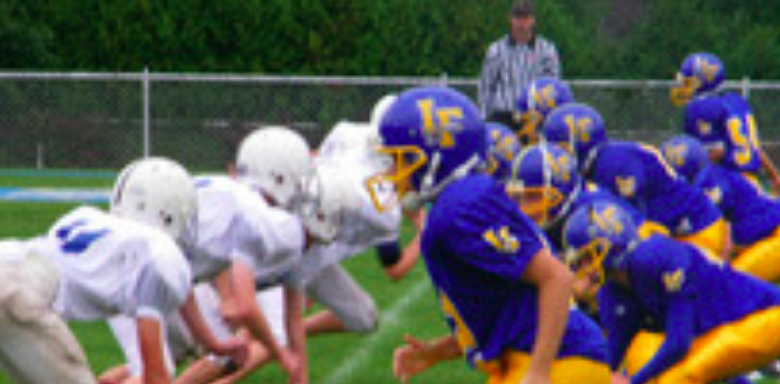Each fall, when the muggy dog days of August arrive, young Lake Forest kids hop out of their parents’ cars and run out to the grass fields behind Deer Path Middle School. Through the sweltering heat, these eager kids learn all about what it takes to be a football player. The Junior Scouts football program seeks to develop young, inexperienced kids and teach them the game while teaching them important life values in the process. Even though the program has been quite successful with its goal, there is an unsettling trend that is not only affecting Lake Forest, but the nation as a whole.
Throughout America, the participation rate in youth tackle football is in a free fall. After multiple studies, many researchers have concluded that repeated head contact from tackle football has led to brain issues in players known as Chronic Traumatic Encephalopathy (CTE). Many former NFL players have suffered, or are suffering from brain trauma, leading to mental issues and suicides as well. With this information in mind, the anti-youth football sentiment has swept across the country, depleting participation numbers in multiple programs, including the one here in Lake Forest.
This month, state representative Carol Sente proposed a new bill to ban tackle football for kids under the age of 12. Titled the Dave Duerson Act, Sente believes the bill will help to prevent brain injuries received from young kids playing the game. While some see the bill as a credible safety measure, others believe there still is not enough information on CTE and football brain injuries to allow government to enforce a rule like this. Whether or not you agree or disagree with the bill, there is one thing that is clear: the youth football numbers are declining and the game finds itself in a precarious situation.
Football is America’s sport. In the fall, Friday nights, Saturday mornings, and Sunday afternoons revolve around football, as millions of Americans crowd into stadiums or in front of TVs to watch the game they love. Football has been quite impactful on American life as well, which is why there are countless stories of the game making an impact on those that play it. For those of us that live on the North Shore, look no further than the city of Chicago. Each day, thousands of youth are exposed to gun violence, gangs, and drugs in their neighborhoods. The game of football gives these at-risk kids an activity to keep them safe and out of bad situations at home. In addition, football builds character, teaches lessons on accountability and responsibility, leadership and struggle, and gives young people the tools to become successful and better human beings in the future. Banning the game from kids that could truly benefit from it could easily cause more problems than the ones we currently deal with.
In the face of the crusade on football, the Heads Up Football Program has come to life to improve the safety of the game. Often forgotten in the football debate are the fundamentals of the game. The Heads Up program has partnered with thousands of teams and coaches across the country to teach the proper tackling techniques to help players play safer. It’s no wonder players suffer from head injuries when you see defenders flying through the field tackling with their helmets first. “Young players need to be taught the fundamentals of the game,” said senior football player Ryan Durburg, “If kids know how to properly play the game, then they will be safer and be prepared for future levels of football.” With drastic safety improvements from new helmets and proper form, the game of football can be safe despite its reputation as a dangerous sport. Instead of banning the game altogether, coaches, players, and parents should work on implementing the game as it’s meant to be played.
Many of the things we choose to do are inherently dangerous. Many Americans choose to drink alcohol, use drugs, text and drive, and more. We are always at risk of injury or death in the things we do, but we choose to do them because we enjoy it. I’m sure there are many kids out there that love football and want to play the game. Yes, the game can be rough and there is merit to the brain injury studies; however, these studies focus on NFL players’ brains and not those of youth players. At this point, there are no conclusions that playing football at a young age is associated with traumatic brain injuries down the road. Additionally, it should not be up to the government to make lifestyle choices for players and their families. I spoke with Lake Forest linebacker John Deering about the bill and he echoed the same sentiment. There are plenty of things I would love for the government to ban, but in this country we still have the right to follow our passions and our dreams despite what others think. Getting in the way of a family and player’s decision to play or not to play is a clear example of impeding people’s ability to follow their passions to their fullest.
In the next decade, high school football–and the coinciding involvement of high school-aged student-athletes within it–will change dramatically. As the popularity of the sport dwindles because of issues like CTE and acts like the one proposed by Carol Sente, high schools will now longer boast football as its flagship program. Additionally, because of the previously mentioned decrease in numbers, a descent in school-sanctioned programs–especially those from schools that are not perennially successful in football–will soon follow. Perhaps the future football will look a lot like high school hockey’s current state, one where school districts or nearby high schools combine to form one unified team due to a lack of participants. Ultimately, we will look on today’s day and age, a time when football is still king in high school sports, and fondly remember them as the good old days of yesteryear. Unfortunately, the popularity of football as a desired sport, perhaps the desired sport, among America’s youth is on its way out. The lessons coveted by many, rooted in toughness and character, composure and camaraderie, will need a new conduit for young, competitive, disciplined boys.
I understand where the Dave Duerson Act is coming from. There is validity in the brain issues down the road, especially at the college and professional level, but if the game is played the right way there’s no reason it can’t be safe for young people. Across the country, youngs kids benefit from the game immensely, as they learn about valuable skills that will help them as people in the future. In a day and age where opinions spread like wildfire, it is important that we think about the entire situation first before enacting legislation that could cause more problems than the one that currently exists.














bob • Mar 27, 2019 at 9:58 am
Each fall, when the muggy dog days of August arrive, young Lake Forest kids hop out of their parents’ cars and run out to the grass fields behind Deer Path Middle School. Through the sweltering heat, these eager kids learn all about what it takes to be a football player. The Junior Scouts football program seeks to develop young, inexperienced kids and teach them the game while teaching them important life values in the process. Even though the program has been quite successful with its goal, there is an unsettling trend that is not only affecting Lake Forest, but the nation as a whole.
Throughout America, the participation rate in youth tackle football is in a free fall. After multiple studies, many researchers have concluded that repeated head contact from tackle football has led to brain issues in players known as Chronic Traumatic Encephalopathy (CTE). Many former NFL players have suffered, or are suffering from brain trauma, leading to mental issues and suicides as well. With this information in mind, the anti-youth football sentiment has swept across the country, depleting participation numbers in multiple programs, including the one here in Lake Forest.
This month, state representative Carol Sente proposed a new bill to ban tackle football for kids under the age of 12. Titled the Dave Duerson Act, Sente believes the bill will help to prevent brain injuries received from young kids playing the game. While some see the bill as a credible safety measure, others believe there still is not enough information on CTE and football brain injuries to allow government to enforce a rule like this. Whether or not you agree or disagree with the bill, there is one thing that is clear: the youth football numbers are declining and the game finds itself in a precarious situation.
Football is America’s sport. In the fall, Friday nights, Saturday mornings, and Sunday afternoons revolve around football, as millions of Americans crowd into stadiums or in front of TVs to watch the game they love. Football has been quite impactful on American life as well, which is why there are countless stories of the game making an impact on those that play it. For those of us that live on the North Shore, look no further than the city of Chicago. Each day, thousands of youth are exposed to gun violence, gangs, and drugs in their neighborhoods. The game of football gives these at-risk kids an activity to keep them safe and out of bad situations at home. In addition, football builds character, teaches lessons on accountability and responsibility, leadership and struggle, and gives young people the tools to become successful and better human beings in the future. Banning the game from kids that could truly benefit from it could easily cause more problems than the ones we currently deal with.
In the face of the crusade on football, the Heads Up Football Program has come to life to improve the safety of the game. Often forgotten in the football debate are the fundamentals of the game. The Heads Up program has partnered with thousands of teams and coaches across the country to teach the proper tackling techniques to help players play safer. It’s no wonder players suffer from head injuries when you see defenders flying through the field tackling with their helmets first. “Young players need to be taught the fundamentals of the game,” said senior football player Ryan Durburg, “If kids know how to properly play the game, then they will be safer and be prepared for future levels of football.” With drastic safety improvements from new helmets and proper form, the game of football can be safe despite its reputation as a dangerous sport. Instead of banning the game altogether, coaches, players, and parents should work on implementing the game as it’s meant to be played.
Many of the things we choose to do are inherently dangerous. Many Americans choose to drink alcohol, use drugs, text and drive, and more. We are always at risk of injury or death in the things we do, but we choose to do them because we enjoy it. I’m sure there are many kids out there that love football and want to play the game. Yes, the game can be rough and there is merit to the brain injury studies; however, these studies focus on NFL players’ brains and not those of youth players. At this point, there are no conclusions that playing football at a young age is associated with traumatic brain injuries down the road. Additionally, it should not be up to the government to make lifestyle choices for players and their families. I spoke with Lake Forest linebacker John Deering about the bill and he echoed the same sentiment. There are plenty of things I would love for the government to ban, but in this country we still have the right to follow our passions and our dreams despite what others think. Getting in the way of a family and player’s decision to play or not to play is a clear example of impeding people’s ability to follow their passions to their fullest.
In the next decade, high school football–and the coinciding involvement of high school-aged student-athletes within it–will change dramatically. As the popularity of the sport dwindles because of issues like CTE and acts like the one proposed by Carol Sente, high schools will now longer boast football as its flagship program. Additionally, because of the previously mentioned decrease in numbers, a descent in school-sanctioned programs–especially those from schools that are not perennially successful in football–will soon follow. Perhaps the future football will look a lot like high school hockey’s current state, one where school districts or nearby high schools combine to form one unified team due to a lack of participants. Ultimately, we will look on today’s day and age, a time when football is still king in high school sports, and fondly remember them as the good old days of yesteryear. Unfortunately, the popularity of football as a desired sport, perhaps the desired sport, among America’s youth is on its way out. The lessons coveted by many, rooted in toughness and character, composure and camaraderie, will need a new conduit for young, competitive, disciplined boys.
I understand where the Dave Duerson Act is coming from. There is validity in the brain issues down the road, especially at the college and professional level, but if the game is played the right way there’s no reason it can’t be safe for young people. Across the country, youngs kids benefit from the game immensely, as they learn about valuable skills that will help them as people in the future. In a day and age where opinions spread like wildfire, it is important that we think about the entire situation first before enacting legislation that could cause more problems than the one that currently exists.
About the Writer
Kyle Wix, Author
Kyle Wix is honored to join The Forest Scout reporting for the In Between the Lines and In the News section covering important school and world issues….